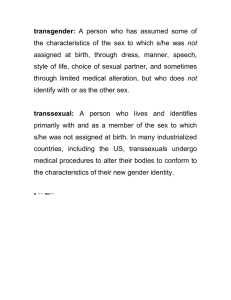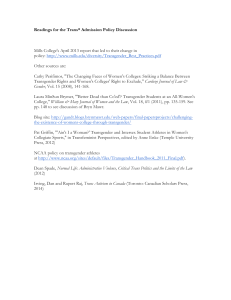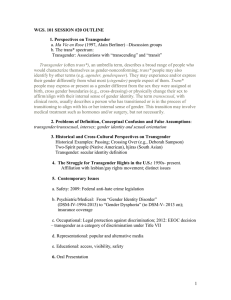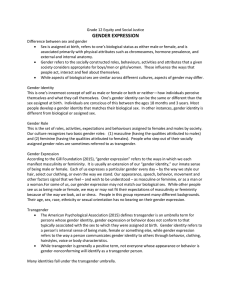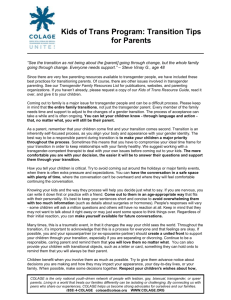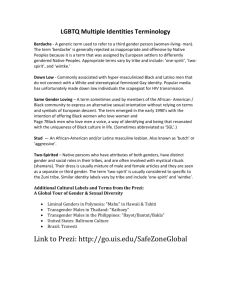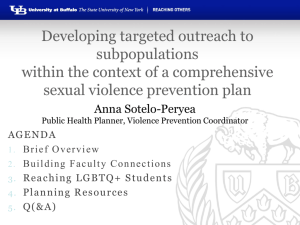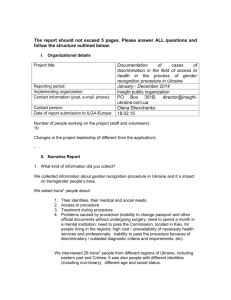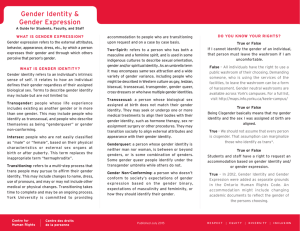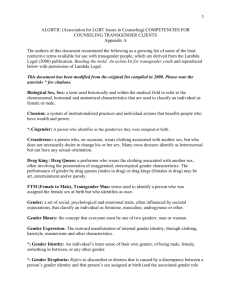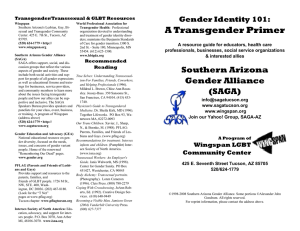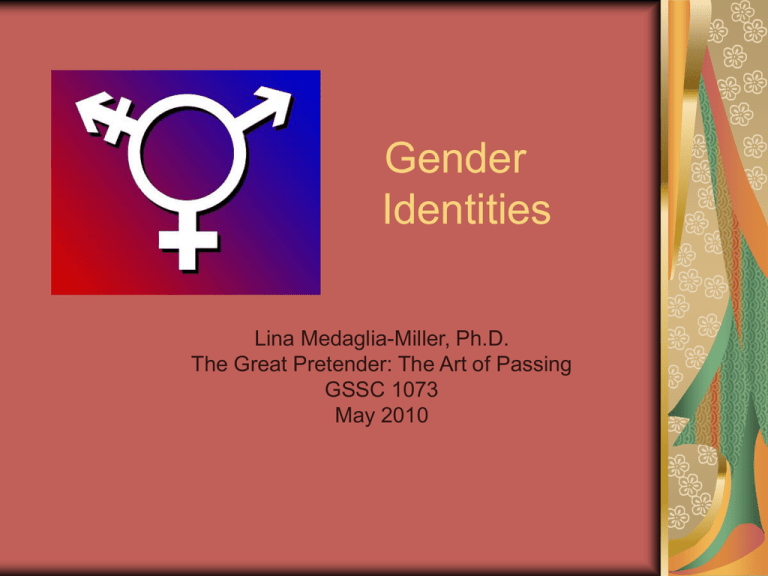
Gender
Identities
Lina Medaglia-Miller, Ph.D.
The Great Pretender: The Art of Passing
GSSC 1073
May 2010
The same Human
Genome Project that told
us that race is an illusion
also tells us the same
thing about gender. The
HGP asserts that genetic
indicators for human
sexuality and gender
constitute about 2% of the
human genome. In other
words, men and women
are about 98% the same.
Why, then, do we have so
many false beliefs or sexist
stereotypes about the
differences between men
and women?
Men are active and women
are passive, say the
traditional psychologists.
Men are logical while
women are emotional,
say the traditional
psychologists.
Yet, if we examine
the real science
behind gender, we
understand that
these perceived
differences must be
based on arbitrary
cultural
programming, or
learned attitudes
and behaviours.
In other words,
men and women
are markedly
different
because human
culture and its
participants
have, over time,
decided upon
what these
differences
would be.
We have
systematically
taught these
sets of
attitudes and
behaviours to
each
successive
generation.
The rigidity of masculine and
feminine roles has been
described as manufactured,
cruel, and certainly
inaccurate. Some would
argue that humanity cannot
and should not be divided
arbitrarily into two genders…
that gender identification is
not rigid, but fluid, and
capable of much complexity.
The complexity of
gender passing and
transgender
identities involves
various combinations
of body, mind, and soul
transformation. It is
important to learn and
understand the many
subtly-different
nuances of gender
identity.
Gender identity
(also known as core
gender identity) refers to
one's chosen social
identity from among the
acknowledged gender
identities present in a
society, representing
one's sex and gender
aspirations.
Some say a person's
Gender identity is the
combination of one's outer
sex, as represented by
one's genitalia, and one's
inner sex, i.e. the inner
sense of being a male or
a female.
Trans educator Monica Helms stresses that Gender expression,
Gender identity, Physical Sex (body presentation), and Sexual
orientation (Sexual attraction) are four completely individual and
separate aspects to a person’s life
In her diagram, each is represented by a line.
A person can identify at any place on those lines.
Transgender is a general
term applied to a variety of
individuals, behaviours, and
groups involving tendencies
to vary from the usual
gender roles.
Transgender is the state of
one's "gender identity" (selfidentification as woman,
man, neither or both) not
matching one's "assigned
sex" (identification by others
as male, female or intersex
based on physical/genetic
sex).
A trans man, transman,
trans guy, FTM is a
transsexual or
transgender man: a
person who was
assigned a female sex at
birth, but who feels that
this is not an accurate or
complete description of
themselves and
consequently identifies
as male.
A “trans woman” (sometimes
trans-woman or transwoman) is
a male-to-female (MTF)
transsexual or transgender
person and the term trans woman
is preferred by many such
individuals over various medical
terms.
Some people labeled and
assigned as males at birth feel
that this is not an accurate and
complete description of
themselves. They may desire to
transition towards a gender role
as a woman. In accordance with
their new role, the label woman is
usually preferred, as a label
denoting the transition would
imply that their identity is
somehow unaccepted or false.
Cross-dressers who do so on
stage or act the part in
movies have entertained
audiences for thousands of
years. Before modern times,
female parts were played by
men because women were
not allowed to be on stage
prior to the 18th century.
Conversely, in 19th century
opera, the parts of boys were
played by women ("pants
parts") because women had
higher voices and could
simulate the vocal sound of
boys.
There are those
who, as a personal
preference or as
an artform, dress
as members of the
opposite gender.
Men who dress as
women identify
themselves as
“drag queens.”
Women, or
female artists,
who dress as
men identify
themselves
as “drag kings.”
Some gender
passers dress as
members of one
gender because they
genuinely experience
themselves as
belonging to that
gender, although their
sexual organs at birth
identified them as
members of the other
gender.
Others still may
crossdress, even
though they identify as
members of
their biologicallyassigned sex and
gender-- an older,
less-used term for
cross-dressing is
transvestism. Not all
cross-dressers are
sexually-oriented to a
same-sex partner or
are transgendered.
Furthermore, some gender
passers, who genuinely
experience themselves as
belonging to the
opposite gender of that to
which they were born, go
to extraordinary measures
(hormone replacement
therapy and sex
reassignment surgery) to
alter the external sexual
characteristics of their
bodies--these individuals
are only one sub-set of a
group who may identify as
transsexuals.
16 year-old German pop
star Kim, formerly known
as Tim Petras
There are historical
instances of women who,
because they desired the
kind of privilege afforded to
men, lived and died as men.
Billy Tipton (1914-1989) is
one example.
Tipton, a talented musician
and bandleader, could not
have experienced any
degree of success due to
the constraints of his
biology.
Only men were allowed to
become leading jazz
musicians. He was
biologically female, but this
fact was not discovered,
even by his family, until he
died.
Another case of gender
passing, whether real or
mythological, is that of the
11th century figure Pope
Joan (Johanna Anglicus). A
devout and intelligent
country girl, she went into
the priesthood as a
man and, due to her skill as
a teacher and
orator, allegedly rose up
the ranks to become
Pope. When she was
discovered, she was
punished for her gender
crossing crime.
Norah Vincent,
dressed as a
man for 18 months
in order to research
the male experience
(Self-Made Man,
2006).
Internationally, we see
a number of examples
of “third gender” people.
In the culture of
South Asia, hijra
(or khusra in
Punjabi) are
physiological males
who adopt feminine
gender identity,
women's clothing
and other feminine
gender roles.
Kathoey or katoey is a male-tofemale transgender person or
an effeminate gay male in
Thailand. The word kathoey is
thought to be of Khmer origin
(the equivalent Khmer word is
"kteuy"). It is most often
translated as ladyboy in English
conversation with Thais and this
latter expression has become
popular across South East Asia
except in the Philippines where
the term bakla is often used.
Nong Tum is perhaps the most
internationally recognised Kathoey
for her portrayal in the film
Beautiful Boxer.
A direct translation of
the Ojibwe term, Niizh
manidoowag, "twospirited" or "two-spirit"
is usually used to
indicate a person
whose body
simultaneously houses
a masculine spirit and a
feminine spirit.
Exercise:
How would you define your gender
expression?
Name 3 things in your upbringing that
encouraged or discouraged your
gender expression.
Name 3 things in the culture in which
you grew up that encouraged or
discouraged your gender expression.
Name 3 advantages and three
disadvantages associated with your
gender expression.
End

